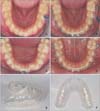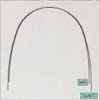1. Yoneyama T, Miyazaki S. Shape memory alloys for biomedical applications. Cambridge: Woodhead Pub.;Boca Raton: CRC Press;2009.
2. Karunakara RV. Nickel titanium wires in orthodontics: a review. J Dent Oral Biosci. 2012; 3:40–42.
3. Proffit WR, Sarver DM, Fields HW. Contemporary orthodontics. St. Louis, MO: Mosby Elsevier;2007.
4. McNamara JA, Brudon WL, Kokich VG. Orthodontics and dentofacial orthopedics. Ann Arbor, MI: Needham Press;2001.
5. Yoneyama T, Doi H, Hamanaka H, Yamamoto M, Kuroda T. Bending properties and transformation temperatures of heat treated Ni-Ti alloy wire for orthodontic appliances. J Biomed Mater Res. 1993; 27:399–402.

6. Santoro M, Nicolay OF, Cangialosi TJ. Pseudoelasticity and thermoelasticity of nickel-titanium alloys: a clinically oriented review. Part I: temperature transitional ranges. Am J Orthod Dentofacial Orthop. 2001; 119:587–593.

7. Kusy RP. A review of contemporary archwires: their properties and characteristics. Angle Orthod. 1997; 67:197–207.
8. Sachdeva R. Sure-smile: technology-driven solution for orthodontics. Tex Dent J. 2002; 119:608–615.
9. Gravina MA, Brunharo IH, Canavarro C, Elias CN, Quintão CC. Mechanical properties of NiTi and CuNiTi shape-memory wires used in orthodontic treatment. Part 1: stress-strain tests. Dental Press J Orthod. 2013; 18:35–42.

10. Sarul M, Kowala B, Antoszewska J. Comparison of elastic properties of nickel-titanium orthodontic archwires. Adv Clin Exp Med. 2013; 22:253–260.
11. O'Brien K, Lewis D, Shaw W, Combe E. A clinical trial of aligning archwires. Eur J Orthod. 1990; 12:380–384.
12. Pandis N, Polychronopoulou A, Eliades T. Alleviation of mandibular anterior crowding with copper-nickeltitanium vs nickel-titanium wires: a double-blind randomized control trial. Am J Orthod Dentofacial Orthop. 2009; 136:152.e1-7. discussion 152-3.

13. Fernandes LM, Ogaard B, Skoglund L. Pain and discomfort experienced after placement of a conventional or a superelastic NiTi aligning archwire. A randomized clinical trial. J Orofac Orthop. 1998; 59:331–339.

14. Abdelrahman RSh, Al-Nimri KS, Al Maaitah EF. A clinical comparison of three aligning archwires in terms of alignment efficiency: a prospective clinical trial. Angle Orthod. 2015; 85:434–439.

15. Riley M, Bearn DR. A systematic review of clinical trials of aligning archwires. J Orthod. 2009; 36:42–51. discussion 15.

16. Ong E, Ho C, Miles P. Alignment efficiency and discomfort of three orthodontic archwire sequences: a randomized clinical trial. J Orthod. 2011; 38:32–39.

17. Flores-Mir C. Attaining a working archwire--which sequence? Evid Based Dent. 2007; 8:48.
18. Mandall N, Lowe C, Worthington H, Sandler J, Derwent S, Abdi-Oskouei M, et al. Which orthodontic archwire sequence? A randomized clinical trial. Eur J Orthod. 2006; 28:561–566.

19. Waters NE. A rationale for the selection of orthodontic wires. Eur J Orthod. 1992; 14:240–245.

20. Papageorgiou SN, Konstantinidis I, Papadopoulou K, Jäger A, Bourauel C. A systematic review and metaanalysis of experimental clinical evidence on initial aligning archwires and archwire sequences. Orthod Craniofac Res. 2014; 17:197–215.

21. Sandhu SS, Shetty VS, Mogra S, Varghese J, Sandhu J, Sandhu JS. Efficiency, behavior, and clinical properties of superelastic NiTi versus multistranded stainless steel wires: a prospective clinical trial. Angle Orthod. 2012; 82:915–921.

22. Maltagliati LA, Myiahira YI, Fattori L, Filho LC, Cardoso M. Transversal changes in dental arches from non-extraction treatment with self ligating brackets. Dental Press J Orthod. 2013; 18:39–45.

23. Dalstra M, Melsen B. Does the transition temperature of Cu-NiTi archwires affect the amount of tooth movement during alignment? Orthod Craniofac Res. 2004; 7:21–25.

24. Fleming PS, DiBiase AT, Sarri G, Lee RT. Efficiency of mandibular arch alignment with 2 preadjusted edgewise appliances. Am J Orthod Dentofacial Orthop. 2009; 135:597–602.

25. Burke SP, Silveira AM, Goldsmith LJ, Yancey JM, Van Stewart A, Scarfe WC. A meta-analysis of mandibular intercanine width in treatment and postretention. Angle Orthod. 1998; 68:53–60.
26. Sadowsky C, Sakols EI. Long-term assessment of orthodontic relapse. Am J Orthod. 1982; 82:456–463.

27. Franchi L, Baccetti T, Camporesi M, Lupoli M. Maxillary arch changes during leveling and aligning with fixed appliances and low-friction ligatures. Am J Orthod Dentofacial Orthop. 2006; 130:88–91.

28. Almeida MR, Futagami C, Conti AC, Oltramari-Navarro PV, Navarro Rde L. Dentoalveolar mandibular changes with self-ligating versus conventional bracket systems: a CBCT and dental cast study. Dental Press J Orthod. 2015; 20:50–57.

29. Lundström AF. Malocclusion of the teeth regarded as a problem in connection with the apical base. Int J Orthod Oral Surg Radiogr. 1925; 11:1022–1042.

30. Strang RHW. The fallacy of denture expansion as a treatment procedure. Angle Orthod. 1949; 19:12–22.




 PDF
PDF ePub
ePub Citation
Citation Print
Print










 XML Download
XML Download